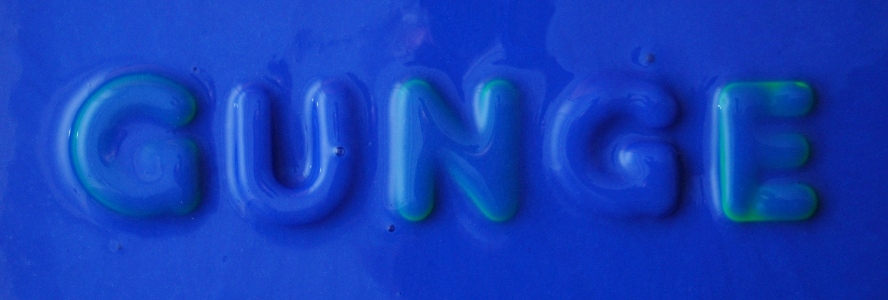
Gunge and Slime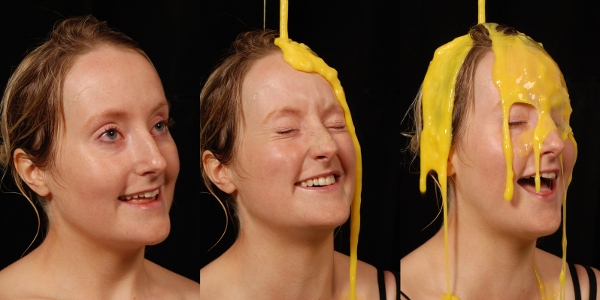
This page
covers detail on options for making gunge and slime, as well as some of
the science behind it. If you are looking for specific recipes, and games,
either have a look at the gunge index page, or these two links;
Definitions
The
terminology for Gunge and Slime tends to vary somewhat around the
world, and between dictionaries, however in general usage Slime and
Gunge are virtually synonymous- typical UK definitions being;
Slime;
n Unpleasant thick slippery substance (1)
Gunge;
n informal Sticky unpleasant substance (1)
In
my opinion, these are not really sufficient definitions to distinguish
between the various types of mess that can be made. To come up with a
suitable definition, I believe that three properties that a fluid may
have need to be considered. These are;
Viscosity;
The resitance of a fluid to shear forces, and hence to flow (2)
Tack(iness);
Ability of a material to bond with another when contact is brief and
pressure is light (2)
Stringiness;
Like string, Fibrous (1)
If
you base the definition of gunge on that typically used in British
television shows, which I believe is how the UK public perceive a gunge
to be, then a suitable general definition would be;
Gunge;
A fluid which is viscous and tacky
Basing
the definition of slime on the familiar children's toys, I believe a
suitable definition is;
Slime;
A fluid which is viscous and stringy, especially one that also displays
tackiness
I
will therefore use these definitions for the rest of this site.
The etymology does differ to that used in the USA.
Making Gunge and Slime
Recipes for various types of gunge and slime can be found on the
seperate pages on this site. For mixing small quantities a small hand
mixer works pretty effectively. For larger quanties a drill mounted
mixer works effectively.
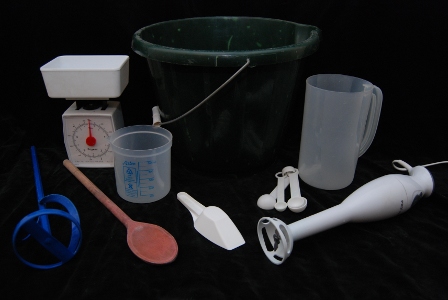 Mixing Items
Mixing Items
Gunge
Technology
Virtually
all the gunges used in film and television, are based on an industrial
thickening agent (gum), either a food or cosmetic ingredient, although
this is not always the case (e.g. Custard for Dick and Dom In Da
Bungalow). Technically they are usually Polysaccharides, a polymer
carbohydrate. In particular many are derivatives of cellulose, of which
there a huge range of products available.
Virtually
any commercial thickening agent could be used, but there are a number
of reasons why a restricted number tend to be selected;
Safety
This
should obviously be of prime importance- this means that the thickeners
should be products intended for food or cosmetic use. Industrial
thickeners for paints, oil well drilling etc are therefore not likely
to be appropriate.
Availability
In
most cases the industrial thickeners are not available directly to the
public. They are bulk packaged (typically in 25kg/50lb sacks) and sold
only via trade suppliers. This means that the products that are
available are those where a supplier is prepared to split a sack to
sell a small quantity- hence the dominance of natrosol in the UK and
Methyl Cellulose in the US.
Temperature
Many
of the easily available food thickeners (such as cornflour/ custard
powder, starch, gelatine etc) either need to be boiled or at least
require boiling water. Whilst this is practical for a few litres at
home, it becomes difficult to make up large batches unless you have
access to commercial kitchen facilities. Some of the industrial
thickeners are also formulated to be dry-mixed with food ingredients
and then thicken when water is added and cooked. This means these types
of thickeners are less desirable for gunge use.
Cost
Can
vary considerably, but can be difficult to compare as different
concentrations will be needed to make a mix of the same viscosity
(thickness). It is therefore best to compare the cost per litre of the
finished gunge.
Mixing
In
my opinion, the ease of mixing is probably the most important factor to
consider. The natrosol mixes very easily, but in my experience some
other thickeners (such as Guar gum) don't. For small quantities a
wooden spoon or food mixer works quite effectively. For larger batches
a paint/ plaster mixer in a drill works very effectively. To disperse
the powder into the water, I tend to measure the required amount into a
jug, and sprinkle into the water as it is being stirred. If the
thickener doesn't flow easily as a powder, I would recommend passing
through a sieve first as if the powder clumps together , it won't
disperse easily in the water and you will end up with lump (3).
When
mixing a large batch up, I would generally recommend splitting it into
smaller batches. This makes the physical handling of the gunge easier,
and reduces the risk of losing the whole batch if something goes wrong.
Typically for the events I have run where 3-400 litres have been
needed, we have split it into 50l batches. In some of these cases we
have mixed the gunge off site from where it is going to be used and
transported in 50l Screw-top plastic kegs (ex mango chutney
containers). Kegs any larger than this aren't really practical for
manual handling without special equipment (3).
Although
not directly broken down by bacterial action, the cellulose based
thickeners can be degraded by enzyme action, resulting in it becoming
watery (4). I find that this tends to happen with the Natrosol gunge
within a few days of being used.
Thickeners
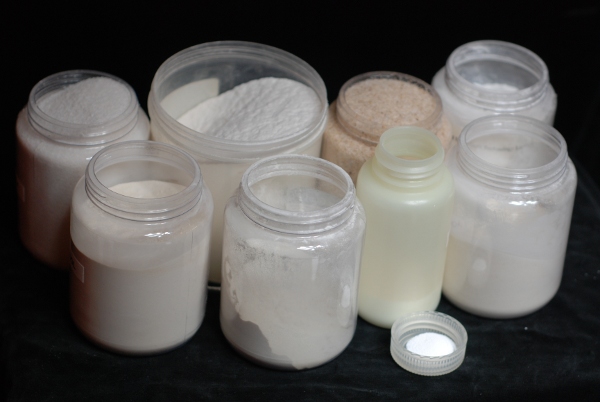 A
range of thickeners that can be used for gunge manufacture
A
range of thickeners that can be used for gunge manufacture
As
already mentioned, there are a wide range of possible thickeners. In
most cases they are polysaccharides of some form. This means they are
chemically similar
to sugar and starches, and are built up from the same basic chemical
molecules- a simple carbohydrate. These are linked together to form a
long chain, making a polymer.
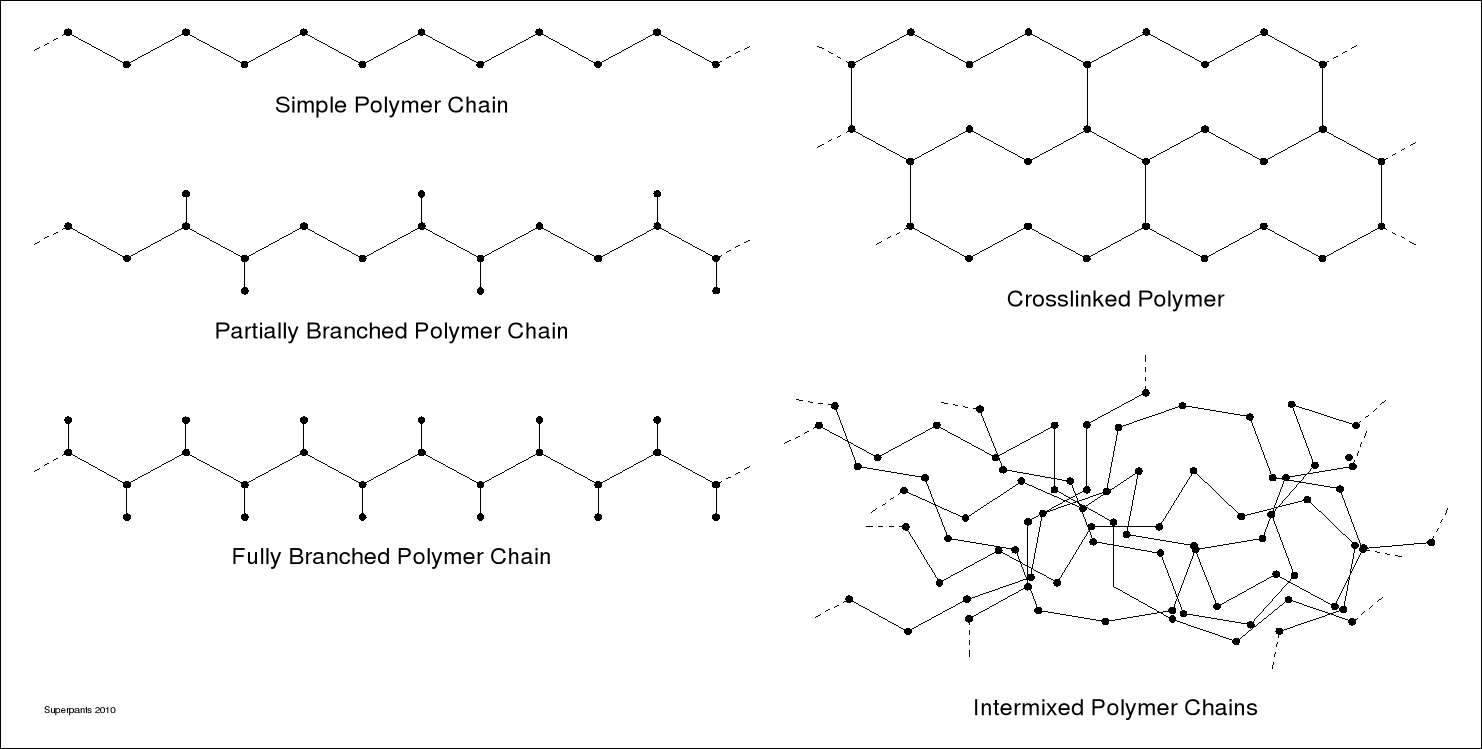 Branching
of Polymers
Branching
of Polymers
Differences
between various grades of the same material are usually down to
different lengths of polymer chain, characterised by the molecular
weight (MW) you may see on a manufacturer's datasheet, and by any
branching of the chain. As a rough and ready approximation, the longer
and/or more branchedthe
chain is, when mixed with water, the more viscous will be the resultant
gunge. Conversely, the powder will generally become more difficult to
disperse, the higher the molecular weight. I will cover the basic of
information regarding each material, as this page is only a brief
introduction to the subject. I will also cover only those
substances known to be used to produce gunge or slimes, or where I have
experience using them. There is plenty of more detailed information
available for those with a more scientific interest in the subject out
there (in particular see ref 4).
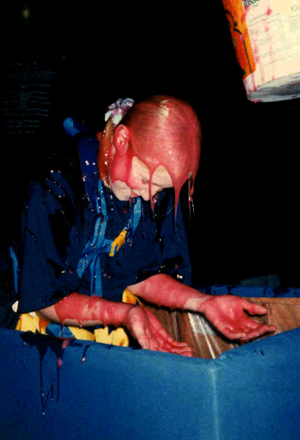
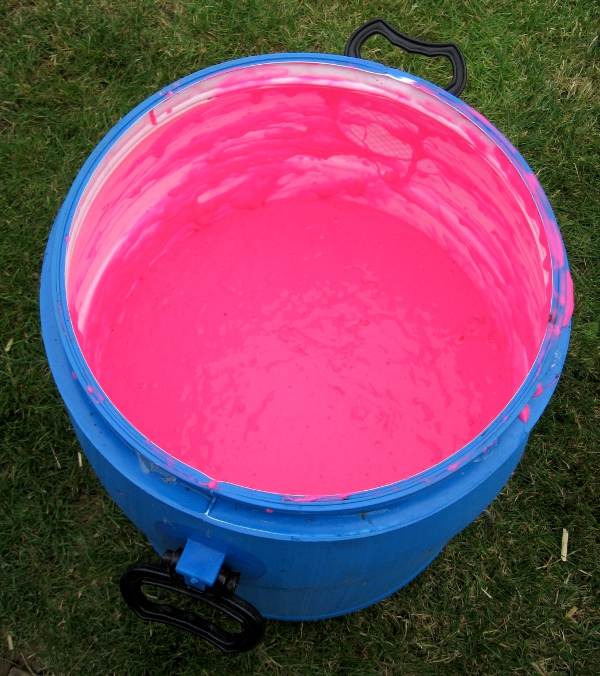 Gunge & Pink Slime made from Guar Gum
Gunge & Pink Slime made from Guar Gum
Guar
Gum (E412)
Guar
is a naturally occurring gum, extracted from the Guar (or cluster)
Bean, most of the world's supply coming from India. It is relatively
cheap, and readily available from health food stores. The first few
events I created Gunge for, I used Guar Gum which was obtained as
samples from a commercial food ingredient supplier. This worked quite
effectively when made up, but proved to be very hard work to mix- the
gum has a tendency to clump, which makes mixing it to smooth
consistency very difficult. The photo at the head of the page is of an
event at the University of Surrey Student's union using this
type. I no longer tend to use it except in the stringy slime
recipes listed below.
Xanthan
Gum (E415)
Xanthan
is the first of the commercially synthesised thickeners, being
manufactured by the fermentation by the bacteria Xanthomanas campestris
of
Glucose
or Sucrose, followed by collection, cleaning and milling. It is
available under the trade names Keltrol and Kelzan. In recent years it
has started to be used as gluten substitute, and therefore has started
to become more easily available from health food shops, larger
supermarkets in the UK and homemade soap suppliers (5). If my memory
serves me correctly, this was the material used for the Run the Risk TV
show
Cellulose
Based Thickeners
All
of these are based on cellulose extracted from vegetable matter and
then chemically treated with a range of processes to alter the
properties (viscosity, dispersion etc) to suit particular needs
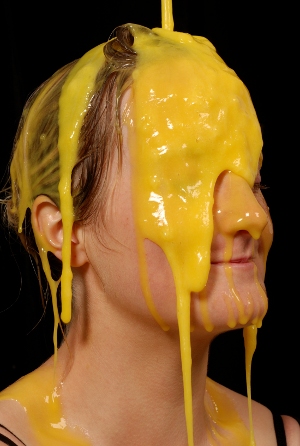 Hydroxyethylcellulose
(Natrosol)
gunge
Hydroxyethylcellulose
(Natrosol)
gunge
in use, coloured with powder paint
Hydroxyethylcellulose
Possibly
the most common cellulose based thickener used for gunge, it is known
by the trade name Natrosol used by the BBC for Noels House Party
amongst other programmes (6), and widely used for charity events and
home gunging.
Methylcellulose
(E641)
A
very common cellulosic thickener, it has a wide range of commercial
uses including being the main constituent of many wallpaper pastes (7).
Known by the trade name Methocel (manufactured by Dow), its most well
known use was used in the Ghostbusters films(8,33) and the bulk of the
slime used in alien resurrection(10,11).
Others
cellulosics
Other
possible cellulose based materials that could also be used if available
include; Hydroxypropyl methylcellulose (E464)- often known as
Hypromellose, Carboxy methyl cellulose (E466) and Sodium carboxy methyl
cellulose (E467)
Super
Absorbant Polymers
Sodium
Polyacrylate/ Potassium Polyacrylate
There
are a number of chemically similar materials, generically known as
Super Absorbent Polymers (SAP), of which Sodium Polyacrylate is the
most
common type, most commonly known as the main absorbent in disposable
nappies and as a soil conditioner. A good background on the material
can be found at ref (12). Like most of the industrial thickeners, their
properties are dependent on the molecular weight and branching, but
also by the physical form the powder
is in (granules/ powder etc), giving rise to a range of possibilities
for different textures. Commercially it is available as
Gellibaff(13)(and other
bath gels). It has some major advantages in that it is easy to mix, and
the viscosity of the fluid can be massively affected by sodium chloride
(table salt), so disposal is easy as the viscosity can be dropped back
to close to that of water (14). It doesn't have good tackiness,
however, and so in my opinion doesn't make a particularly good gunge
(3).
Polyacrylamide
Polyacrylamide
is chemically similar to Sodium Polyacrylate, but is not affected by
the addition of table salt (14). Commercially it is available as
'Yuck'(15).
Polyacrylamide (aka non-ionic polyacrylamide) is used as a
soil stabiliser and water retainer in agriculture and soil remediation in mining
as well as finding uses as a lubricant in oil well drilling, and as a flocculant
in water purification (39). These chemicals are also used widely in cosmetic
applications to enhance the feel of a product, and form a stable lubricant film
on hair when dried and so finds wide use in shampoos and conditioners (40). Some
applications have also been found in pharmaceuticals both in tablets and in
other dosing methods. (41).
I have yet to find a good source of suitable grades
(cosmetic) for home use, but versions are now starting to become available as
toys as ’Yuck’ in the USA and ‘Slime Play’ in the UK (manufactured by Gelicity, sometimes carried in
Poundland). Both of these sources are relatively reasonably priced compared to
the available alternative methods of making slime.
Polyacrylamides were used in the Ghostbusters films to lend
stringiness to the methylcellulose based slimes.
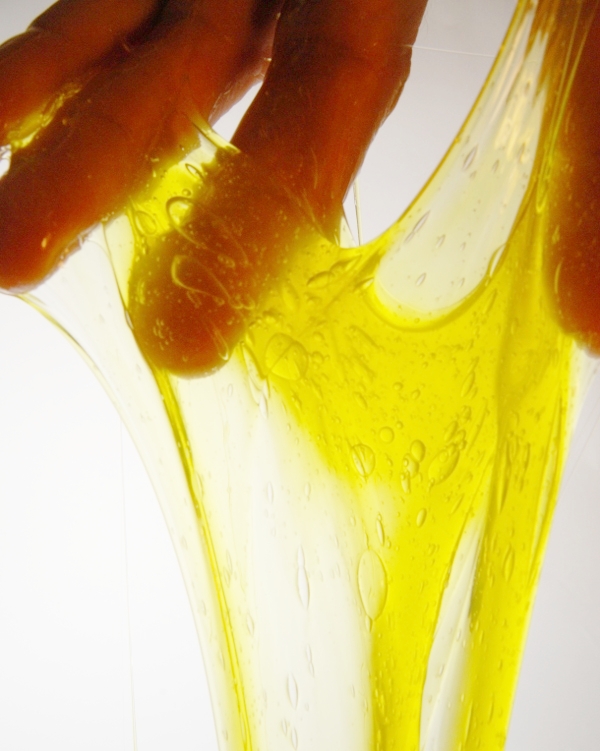 Polyox
Slime
Polyox
Slime
(Coloured with cosmetic pigment)
Polyethylene
Oxide
Polyethelyne
Oxide (PEO) (or Polyoxyethelyne (POE)) is another high molecular weight
polymer, the common trade name being Polyox (16). Typically it will
have a molecular weight above about 100,000. Below this it will tend to
be known as Polyethelyne Glycol (PEG), the common trade name here being Carbowax
(17). Both PEG and PEO are widely used in cosmetics as well as such
items as vetinary lubricants (18).
Polyox
is pretty difficult to mix as a raw material (3). Commercial products
therefore mix other materials such as sugar to make dispersion easier
(18).
Psyllium/
Ispaghula Husk
Another
naturally occurring thickener- this is made from the ground up husk of
the Plantago Ovata seed. When mixed up it tends to form a stringy slime.
It
is sold in health food stores as a milled form as a form of dietary
fibre supplement, but in this form is not particularly soluble as it
clumps on mixing with water. For this reason there are a wide range of
purified and prepared formulations on the market, sold as bulk forming
laxatives. The formulations vary, but all have the common form of
coating the powdered husk with another substance to avoid the clumping
(19). The two most well known brands are Fybogel in the UK and
Metamucil in the US. Best results seem to be obtained by either boiling
a mixture of the husk powder and water or heating in the microwave for
a few minutes. Typically the concentration needs to be approx 2% by
weight, but as this is a natural product, there is significant
variation between supplier and batch (3).
Wallpaper
Paste
In
the UK it is difficult to obtain wallpaper paste that hasn't had a
fungicidal additive mixed in with it. For this reason I wouldn't
consider using it as a gunge. Chemically it is often a methylcellulose
grade or a Dextrin- a modified starch (4,7).
Theatrical
Slosh
A
perennial favourite in pantomimes in the UK is the slapstick scene-
epitomised by the laundry scene in Aladdin. The particular mess in
this and in clowning shows is generally known as slosh.
There
are many variations on the recipes for slosh, but the key features
are that it is soap based, and usually a foam (26).
The
common base recipe is to grate a shaving stick into a bucket,
sometimes quoted to be one manufactured by Erasmic (35,26,36), followed
by whipping up with hot/ boiling water. If manufacturing a bucket or
more, a paint stirrer attachment for a drill works well (3). One
stick with 1/2l of water and makes approx 1 Bucket of slosh.
Other
ingredients can be added including food colouring or poster paint to
colour the slosh (best added to the water first). I have also seen
cornflour, glycerine and gelatine quoted as other useful additives,
but haven't yet investigated these thoroughly.
A
further variation I have rarely seen is to dissolve soap flakes into
boiling water with a small quantity of glycerine and food colour
(3,37).
See seperate page for further details Slosh
Jelly/
Jello/ Gelatine
In
small quantities this is easily available and easy to make, however I
avoid using it for a number of reasons- Primarily it is difficult to
make in volume as it requires boiling water and refrigeration. Couple
this with the fact it's viscosity is temperature dependent and doesn't
store well when mixed makes it difficult to use. SAPs are commonly used
to give a jelly effect for example for wrestling in.
Denture Fixative
Denture
fixative has been sugeested as suitable to make a slime by those making
home movies (34). Wernets/ poligrip is available and contains a
cellulose thickener. It works but is an expensive way of getting the
thickener (3).
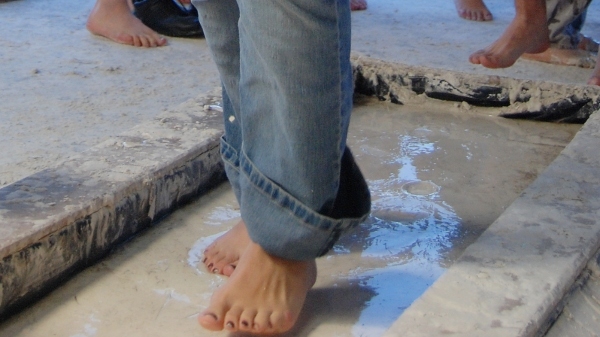 Cornflour
used for "walking on custard"
Cornflour
used for "walking on custard"
Cornflour
The
basis of custard, can form a highly thixotropic liquid when mixed with
water- This is the basis of the walking on custard demonstrations.
(e.g. the well known Brainiac episode). The proportion of Cornflour to
water need to be very high so this is not a cheap activity in large
volumes (3).
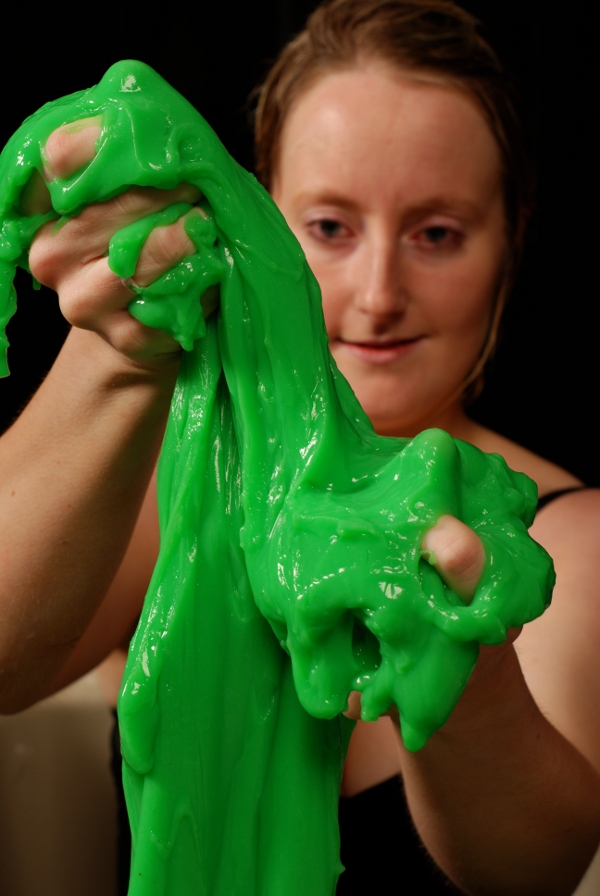 Guar
Gum Slime
Guar
Gum Slime
(cross-linked with borax and coloured with poster paint)
Sodium Alginate (E401)
Sodium
Alginate has been used for simulating thick fluids such as mud and tar
in TV use (38), but seems to have fallen out of favour in recent times.
It should not be confused with dental alginate used for lifecasting
which has additional chemicals to cause it to gel, rather than thicken.
Cross-linking
Some
of the thickeners have the ability to have their chains cross-linked to
make the viscosity much higher, by the action other chemicals. Both PVA (poly
vinyl alcohol) and Guar Gum are particularly good at cross linking with
a common chemical, sodium tetraborate- more normally known as borax
(4). The cross-linked guar gum is the material sold in toy
stores
as slime- but can be fairly easily made at home. There are good recipes
for this at 'Chemistry in the Toy Store' (20), along with a good
explanation of the chemistry and for a full recipe see the slime page.
Grades of thickener
Whilst I have treated the various thickeners as single
types, there is in reality a significant number of variations of each type, from
different manufacturers, and grades within their ranges. Typically the factors
that influence these grades include molecular weight and molecular weight
distribution, branching of polymer chain, powder sizes and ‘substitution’- the
addition of other chemical compounds onto the thickener chain. As there is such
a variety of possibilities it is always worth experimenting with the exact grade
you intend to use.
Brand Names And Trade Marks
Many
thickeners are sold under brand names or trade names, but in at least
some cases, a range of different types of thickener are sold under the
same brand name, with the discernable difference being the code for the
grade of the material. Particularly notable examples are Tylose and
Dow's Methocel- Whilst commonly Methyl Cellulose, a number of
other materials are sold under the same brand,.
Colouring
and colourants
There
are a number of options open for colouring the gunge, each with their
own benefits. I would recommend using products known to be safe for skin contact.
It is worth bearing in mind that to produce an intensely coloured
gunge, quite a lot of the dye will be needed- It is therefore inherent
risk that it will stain. To reduce the risk of damage to clothes, avoid
white or light colours and wash them as soon as possible after the
event, preferably before it dries on (3).
Whilst
most users will tend to colour their gunge with powder paints, liquid
tempera (poster paints) or food colourings there are a wide range of
other options available. Commercially, colourants are split in to two
main classes; dyes and pigments, defined as follows;
Pigment:
A pigment is a finely divided solid colouring material, which is
essentially insoluble in it's application medium” (21)
Dye:
Soluble colourant- may be soluble in water or other liquids
The
ideal colourant for our uses would be readily available in a wide range
of colours, non-staining, non toxic, vivid and available as both opaque
and clear versions, as well as being low cost. Unfortunately the
perfect solution does not seem to exist, so we are forced to compromise
on some factors, in particular with the commonly used colourants the
inherent risk is that it will stain. To reduce the risk of damage to
clothes, avoid white or light colours and wash them as soon as possible
after the event, preferably before it dries on.
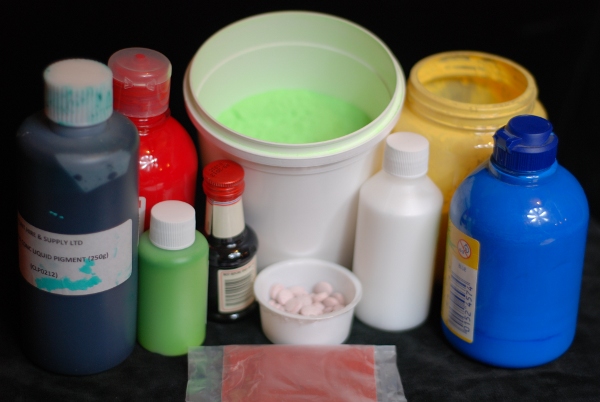
 A Wide Range of Possible Colourants & Professional Food Colours
A Wide Range of Possible Colourants & Professional Food Colours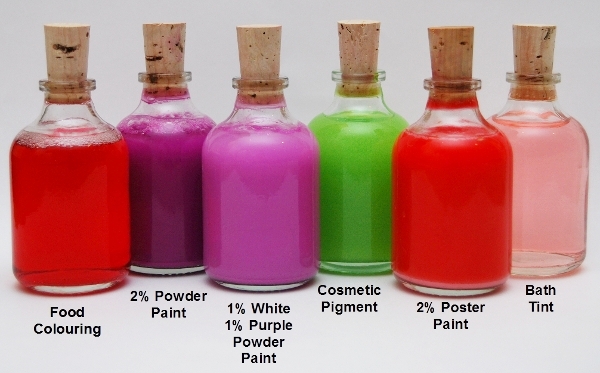 Colourants mixed at usable concentrations
Colourants mixed at usable concentrations
Food
colouring
Widely
available, safe and cheap. In my experience can stain quite badly as it
is a dye, and therefore designed to be absorbed onto food. It is clear
so means that mixed gunge will not be very visible when not in bulk (3).
Food colour for domestic uses is not normally sold as opaque
(certainly in common UK brands such as Dr Oetker), this may not be an issue if
you wish to create a clear, coloured goo, but if you want an opaque effect, you
will need to consider opacifiers. You may be lucky in some areas and find a gel
or paste available that has opacity, and whilst I have yet to find a UK source,
I understand that there are white food colours in existence in these
ranges.
Industrial food colours can however be bought as opaque
liquids, these are typically very viscous or paste (3) so that
the opacifier does not settle out in storage or transit. Opaque food colours type were
certainly used in Get Your Own Back.
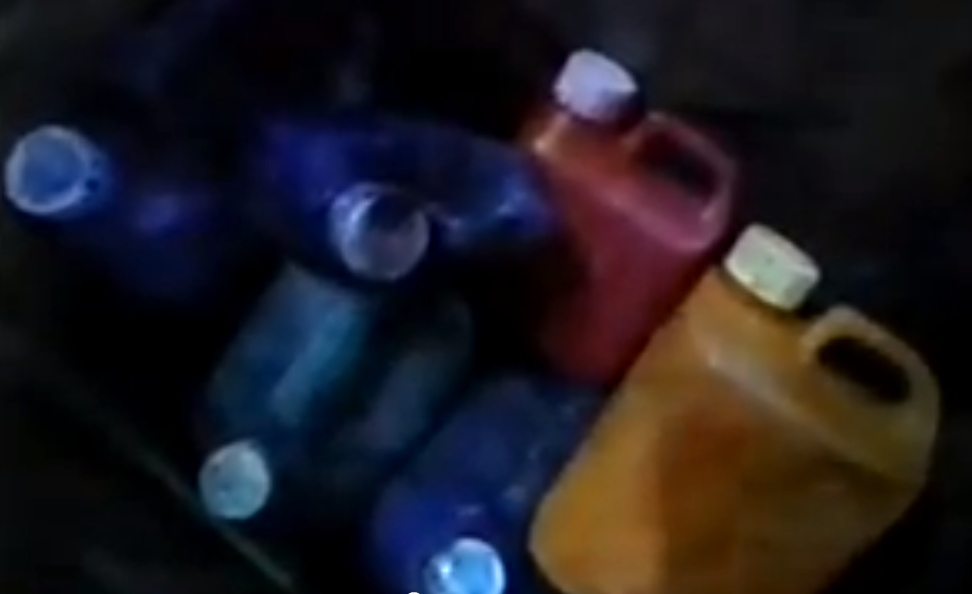
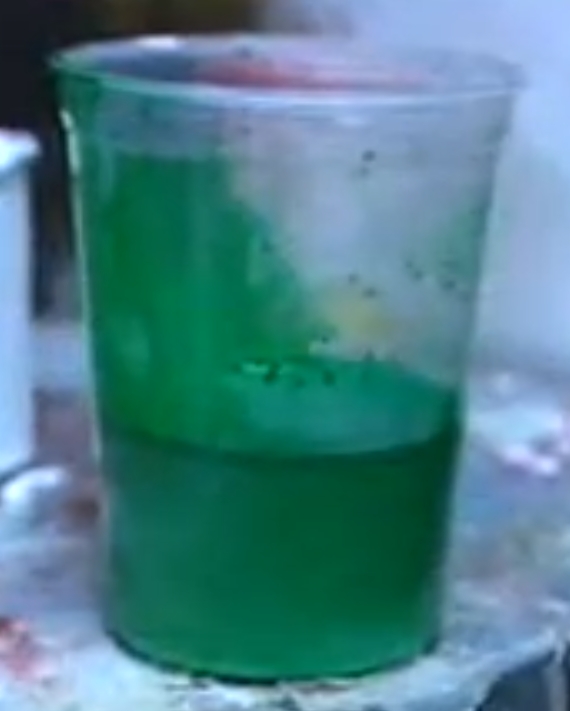
Get Your Own Back Colouring
Possible options for more commonly available opacifiers
include milk (if you are using the goo immediately) and cornflour (cornstarch).
I have used flour, but it results in clumping and mixing difficulties as well as
difficulty in cleaning up the slime and fairly poor opacity as well.
Powder
Paints
This
is the colourant used in some of the commercial suppliers pre-mixed
powders (22). It is a pigment, so is generally less staining than food
colouring and is opaque (at least if mixed in sufficient
concentrations). It seems to be getting superseded for home kids
painting (in the UK at least) by the premixed paints, and is so
becoming slightly more difficult to obtain on the high street than it
once was.
The
composition is based on a pigment, an opacifier (usually titanium
dioxide), some binders (can be dextrose based) and an ‘extender’,
usually calcium-carbonate (chalk) (21). In my opinion the presence of
the extenders reduce the vividness of the colour, and for gunge, the
binders aren’t necessary. If someone could formulate a powder with
these changes, we’d have the perfect colourant!
However,tfor larger quantities of gunge, a suitable
chalk powder could be used as an opacifier and to reduce the cost of colouring
the slime, particularly as the cost of colouring to an intense, opaque shade can
be as much as the thickener in some cases.
I
believe it is the type of colouring used in at least some of the
commercially available suppliers products (22).
Liquid
Tempera (Poster Paint)
Widely
available, safe and opaque. These are a good all round choice,
particularly as the range of colours is wide and includes fluorescent
‘neon’. The colours do seem to be more vivid than the powder paints.
The main disadvantage is that some colours will stain, and a reasonable
quantity is needed to get a suitably opaque mix. I have also been
unable to find much useful information on the formulation, particularly
on binders or other chemicals used.
Helizarin
Helizarin
is a trade name of BASF, but is of note as it is the range of dyes
quoted as being used by the BBC for their gunge (6). It is not easily
available, although there is one trade source of small quantities in
the UK. It produces a very vivid colour, and is in my opinion the best
looking colour available, but it is not sold as safe for skin contact
(23), as well as being staining. I would not therefore recommend it for
home use.
Bath
Tints
These
are available as tablets for colouring bath water, and are sold under a
number of names, typically 'Fizzy bath tints'. They provide a way of
colouring that is not likely to stain, but only have a minimum of
colouring power (3).
Cosmetic
Dyes & Pigments
There
are a wide range of dyes and pigments available that are used in
cosmetics, and hence are safe to use. After spending some time
investigating and experimenting with these I have come to the
conclusion that for normal use they do not offer any great advantage
over the other options, and are not as easy to obtain. They main
benefit I can envisage with these are the availability of specialist
additives like pearlising agents and fine glitters that could add
‘sparkle’ to a gunge.
Colouring Intensity
Even a small amount of colourant will give an intense and
opaque effect when the gunge is in bulk, however when the gunge is in a thin
film, as will occur when it is being used, significantly more colourant will be
needed if you want the object/ person underneath to be obscured. Dependent on
the application, I will typically use between 1 and 2% by weight of powder
paint to produce a suitably opaque and intense colour. I have gone as far as 5%
when I have had a need to get a particularly strong effect in photographs. If
you need opacity, but not a vibrant colour then a mix of white powder paint to
provide the opacity and another colourant can give a desirable, but more pastel
effect.
These figures should be taken as a guide only as there will
be variation between different manufacturer’s paints and between colours in
their range. If a particular effect is needed then I’d recommend experimenting
first. It is also worth noting that at the higher concentrations, some of the
filler in the paint will slowly drop out of suspension. It is therefore a good
idea to give the gunge a good stir before use.
The following image gives some comparison of the opacity and
covering power of different concentrations, using Natrosol and NES Arnold blue
powder paint.
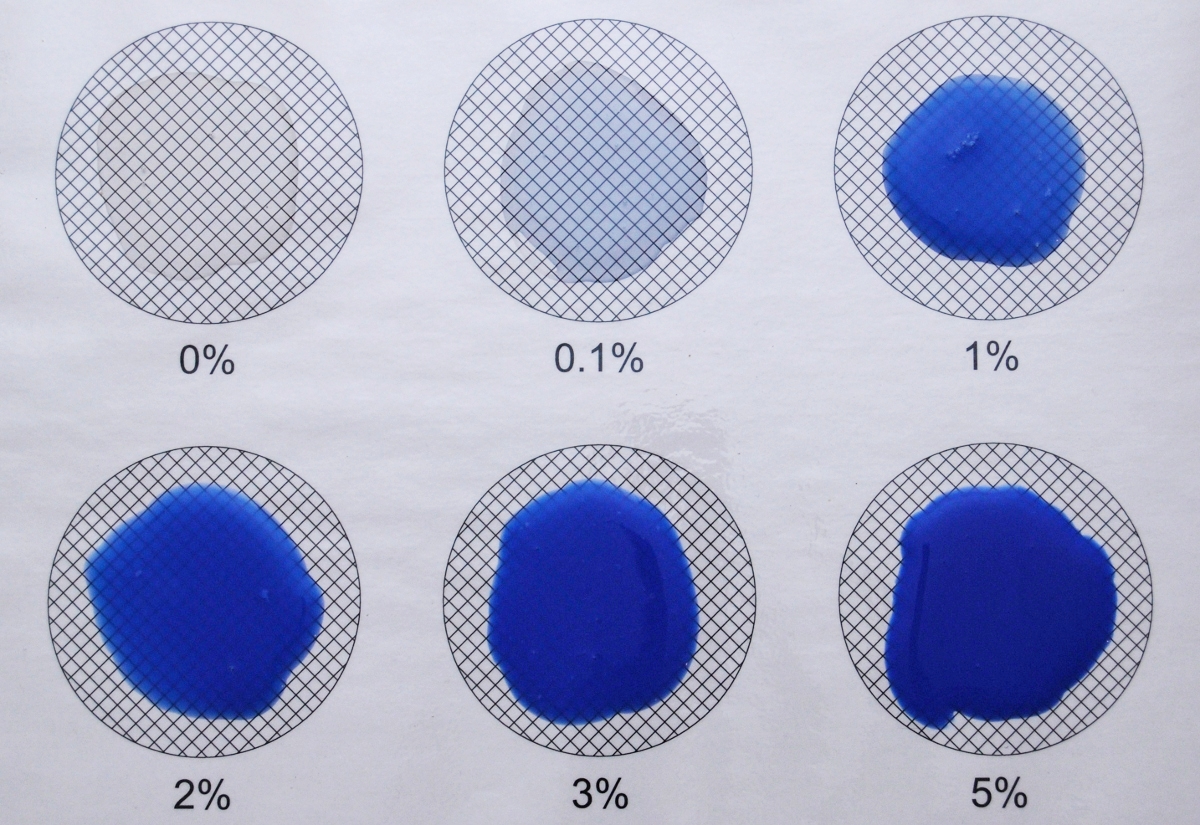 Paint ConcentrationsBlue powder paint mixed with water and Natrosol at 1%
Paint ConcentrationsBlue powder paint mixed with water and Natrosol at 1%
Further
Information
There
are a number of things picked up whilst researching this page that
don’t neatly fall under any other category, so I’ll include them here.
Rheology
There
is a branch of science devoted to researching and defining how
materials flow, known as Rheology. It is an area of research that has
wide ranging effects that might not be immediately obvious. Some
example areas are; flow of plastics in moulding & resins in
manufacturing composites, manufacture of paints, drilling mud for oil
well sinking, food processing and manufacture of the next ‘extreme
hold’ hair gel.
The
rheology of the materials is of interest to us- probably most
importantly, the viscosity of the material. This is described at the
start of this article. The other key properties that a fluid may have
that are interest are defined as;
Newtonian
Viscosity; Newton's law of viscosity states that the shear stress is
directly proportional to the shear rate (7). i.e. viscosity is
independent of the forces applied to the fluid, although temperature
may have an effect.
This
area will be expanded soon- please check back!
Cost
It
is difficult to determine categorically which gunge or slime will be
the most cost effective for your needs, but it is possible to compare
relative costs based on a finished volume. The following table aims to
do this, and is primarily based on UK pricing - Please bear in mind
there are many factors that have a bearing on the cost including
concentration, quantity bought, colouring, postage, material grade etc.
Although there are multiple factors to be considered, they are unlikely
to significantly alter the relative position in the list.
| Material | Concentration | Price Per Litre
Finished Gunge | Relative cost |
| Xanthan Gum | 1% | £0.07 | 1 |
Super Absorbant Polymer
'Gellibaff' | 0.25% | £0.08 | 1 |
| Guar Gum | 1% | £0.18 | 2 |
Hydoxyethylcellulose
'Natrosol' | 1% | £0.20 | 3 |
| Supermarket Xanthan | 1% | £0.24 | 3 |
Methylcellulose
'Methocel' | 1% | £0.29 | 4 |
| Gunge Powder | 1% | £0.94 | 13 |
Flourescent Gunge Powder
'Paint Party Powder' | 8% | £1.60 | 22 |
| Pre-mixed Gunge | N/A | £2.00 | 27 |
Compiled Feb 2014
Prices for uncoloured powder, nominal 1kg pack size
The
obvious conclusion is that unless you really need the convienence of
the smaller packaging (ie for one bucket), You are likely to be much
better off buying the raw powders.
Mixing
Mixing small quantaties of gunge is relatively easy, and shouldn't cause much
issue in producing a homogenous mix (ie not lumpy), however mixing large
quantities brings it's own issues.
I have recently mixed a large quantity
in one batch (500 litres) and have experienced some difficulties. On previous
occasions needing larger amounts (300-400l), I have always seperated the batch
into smaller quantities, typically of around 50 litres each, mixed seperately
and combined, typically using a paint mixer in an electric drill. Whilst some
care is needed to ensure the thickener is added at a suitable rate to avoid
clumping, the power of the mixer is sufficient in this size batch to keep it
well agitated, and hence get a good mix.
When the process is scaled up, a
drill mixer isn't adequate to mix the whole tank simeltanously, and hence any
thickener missing the mixing zone will sit on the surface for some time, and
tend to clump. The problem gets worse as time goes on as the viscosity of the
mix increases, and hence hinders mixing further. In the recent experience this
meant we ended up with the 'fish eyes' layer of not fully mixed material on the
surface. Once this has occured it is very difficult to recover from. For this
application it wasn't a major problem, but were viscosity be needed to be
closely controlled it may be an issue.
Should you therefore need to mix
large quantities I would recommend mixing in as small a batch as practical, and
using the most powerful stirrer available (may be a plaster mixer) as well as
being as careful as possible to pour the powder into the agitated are of the
mixing only (3).
For more details on mixing bulk quantities, please se the bulk page; Bulk Gunge
Movie
Slime/ Monster Slime
Apart
from the bulk quantities of slime that is used in movies usually being
manufactured from methyl cellulose (8,11) there are a number of other
substances used. The most obvious being the use of KY Jelly in the
alien films (11). The one however of most interest is Ultra Slime.
Ultra Slime is manufactured by a company called Ultra Materials. For a
few years it appeared they weren't r trading and so the mantle of
providing stringy slime fell to a couple of other
companies, however they seem to be back in business again in 2015 (44).
The companies that produce this type of slime understandably don’t
publish
the formulations, however from studying of a material safety data sheet
(29), and by experimentation (3), I would postulate that the key
ingredient is polyox or polyacrylamide which is blended with
methylcellulose.
Similarly
the other commercially available stringy slime powder, ‘Sticky Yuck’ I
would postulate is a blend of Polyox and sodium polyacrylamide
(3,14,15).
Nickleodeon Green Slime
One
of the most well known users of slime is the children's television
channel Nickeleodeon. The slime they use is manufactured by a company
called Blair Adhesives in the US (30,31,32,33).There is no indication
of what the slime is based on, although the colouring is known to be
food colouring (32)
Safety
Whilst
I have been careful to only list materials on this page that are not
known to have any significant health risks associated with them, they
cannot all be classed as completely hazard free.
The
largest single issue is the slipperiness of the mix- it can be very
easy to slip over on. It is therefore essential to consider this when
planning any activities involving gunge, including clean up and washing
off as the most significant effects will be found on a smooth surface
such as a bath!
Most
of the materials are supplied as relatively fine powders, and as such
create nuisance dust. It is therefore worth wearing a dust mask when
handling. Likewise if this dust gets into eyes it can cause irritation.
Most
of the materials are sold as safe for skin contact (e.g. cosmetics) and
to date I have not had any problems with this. I would however be
slightly wary of allowing prolonged skin contact with the colourants as
it may stain!
All
of these main materials (with one exception- see below) are not
hazardous when eaten, however many are used as laxative additives, so
it would probably be unwise to consume large quantities (4)!
Borax
(Sodium Tetraborate) is the main exception to the above- It is not safe
for consumption, and should therefore be handled and used carefully so
as to avoid ingestion, although in the quantities actually present in
slime it should not cause any concern. (27)
In
addition to the specific information above, general safe chemical
handling practice will further reduce the risk of any issues, in
particular;
Store
materials in sealed, well marked, containers in an area out of reach of
children and pets
Wash
hands before and after handling these materials
Dispose
of excess/ used materials/ empty packaging responsibly
Wear
dust mask when handling powders
Clean
up any spills quickly- Avoid using water to stop the area becoming
slippery
Do
not use utensils/ containers/ cleaning cloths that will be later used
for food
Unsafe Materials
There may a temptation to use other thick or gooey materials
for messy activities, and some may be tempting due to cost and availability. I
would strongly recommend not using products other than those known to be safe-
in particular I would suggest that you do NOT use any of the
following;
Plaster (building, casting or plaster of paris)
Risk of burns. Plasters give off heat as they cure, which can
be intense. There is at least one case of amputation needed after plaster burns
(42).
Cement
Risk of Alkali burns. Cement has caused many recorded issues
for workers in contact with cement during the course of their employment (43).
Paints
Unless sold as children’s paint, I would avoid any other
types of paint due to the presence of solvents, other toxic ingredients and in
some cases heavy metals in some types. Unless you are familiar with the
chemicals used it will be difficult to ascertain the risk of any particular
type.
Motor oil/ Grease (Especially used)
Risk of dermatitis or cuts. Used oils can contain complex and
unknown compounds that can be hazardous to health. Metal particles may also be
included.
References
(1)
English Dictionary, Home Edition, Collins, ISBN 978-0-00-784932-1
(2)
Materials Science and Technology Dictionary, Prof P.M.B. Walker,
Chambers,
ISBN 0-550-13249-x
(3)
Personal experimentation
(4)
Industrial Gums- Polysaccharides and Their Derivatives, Second Edition,
Roy
Whistle, Academic Press 1973, ISBN 012746252
(5)
http://www.thesoapkitchen.co.uk/
(6)
BBC red nose day website 1999
(7)
http://www.britannica.com/EBchecked/topic/160522/dextrin
(8)
Quest- Marshall Cavendish Partwork
(10)
Rosie O'donnell show interview with Sigourney Weaver, Nov 26th, 1997
(11)
Alien The Special Effects, Don Shay & Bill Norton, Cinefex ISBN
1-85286-695-0
(12)
http://www.m2polymer.com/html/chemistry_sap.html
(13)
Gellibaff MSDS- http://www.gellibaff.com/uploads/1/3/6/3/13638060/msdsheet-4.pdf
(14)
Superabsorbent Polymers Science and Technology, F.L.Buchholz &
N.A.Peppa, ACS Symposium Series 573, ISBN 0-8412-3039-0
(15)
Buckets of Yuck MSDS- http://www.buckets-o-fun.com/gamesheets/MSDS.pdf
(16)
Dow Polyox Water-Soluble Resins Datasheet- 326-00001-0302 AMS
(17)
Dow Carbowax and Carbowax Sentry Datasheet- 118-1260-0306 AMS
(18)
J-Lube MSDS- http://www.jorvet.com/msds/j_lube.pdf
(19)
Patents; US20050031714, US4321263, US5126150
(20)
http://www.chymist.com/toy_store.html
(21)
Colour Chemistry, R.M. Christie, RSC Paperbacks, 2001, ISBN
0-85404-573-2
(22) Youtube video for thegungeshop.com-
http://www.youtube.com/watch?v=9G0lPyRKLqM
(23) Concentrated Liquid Pigment MSDS- Flint Hire and Supply
(24)
http://www.britannica.com/EBchecked/topic/160522/dextrin
(25)
Dow Methocel Cellulose ethers technical handbook, 192-01062-697GW
(26)
http://amdram.co.uk/forums/index.php?showtopic=5342&hl=slosh
(27)
http://www.thesoapkitchen.co.uk/images/MSDS/powders%20&%20granules/MSDS%20Borax.pdf
(28)
http://www.cosmeticsbusiness.com/technical/article_page/Repeat_performance/47074
(29)
Super Goop MSDS, Roger George Rentals
(30)
http://www.nick.com/shows/kids-choice-awards/pictures/kca-2010-making-of-flipbook.html
(31) http://www.blairadhesives.com/Special_Effects.html
(32) http://blog.zap2it.com/tvfashion/2010/03/to-a-funeral-we-wear.html
(33) http://www.nytimes.com/2008/03/29/arts/television/29nick.html
(34) http://www.theeffectslab.com/forums/viewtopic.php?t=1786
(35)
http://www.erasmic.co.uk/shave-brush.html
(36)
Conversations with professional stage manager
(37) Blue
Peter episode late 1980s- from memory
(38) Special Effects in Television, Second Edition, Bernard Wilkie, Focal Press, ISBN 0-24051361-4
(39) Water Soluble Polymers: SNF Floerger product brochure. http://www.snf-group.com/
(40) Flocare: SNF Cosmetics product brochure. http://www.snf-group.com/
(41) Water Soluble Polymers for Pharmaceutical Applications.
Veeran Gowda Kadajji and Guru V. Betageri . Polymers 2011, 3,
1972-2009
(42) http://news.bbc.co.uk/1/hi/education/6485481.stm
(43) http://precast.org/2010/05/cement-burns/
(44) http://www.ultramaterials.com/
Supplier
Details
I understand the Basic Chemical Company are no longer providing Natrosol as of 2023
The
Basic Chemical Company (UK) Ltd
Hillbottom
Road
Sands
Industrial Estate
High
Wycombe
Buckinghamshire
HP12
4HJ
01494
450701
http://www.basicchemicals.co.uk/
The
Soap Kitchen (warehouse),
Units
2 D&E Hatchmoor Industrial Estate,
Hatchmoor
Road, Torrington,
Devon
EX38
7HP. UK.
01805
622944.
http://www.thesoapkitchen.co.uk/
A
significant amount of effort has gone into researching this page.
Please do not plagiarise this work without contacting me for permission
first- I will usually say yes! This page will be updated periodically
as and when new I find new, relevant information.
As with other projects on this
site, feel free to contact me if you have opportunities to use the
technology- I am always interested in collaborating on interesting projects, be that
photographic, TV, Film, Nightclub, Exhibitions or other uses. Contact details are
on the about me page.







